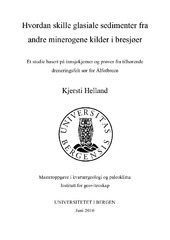Hvordan skille glasiale sedimenter fra andre minerogene kilder i bresjøer - Et studie basert på innsjøkjerner og prøver fra tilhørende dreneringsfelt sør for Ålfotbreen
Master thesis
Permanent lenke
https://hdl.handle.net/1956/12593Utgivelsesdato
2016-06-01Metadata
Vis full innførselSamlinger
- Department of Earth Science [1033]
Sammendrag
Glacier reconstructions from around the world help us understand how the climate has changed over time. Lake sediments have been used as archives for glacier activity for a long time. The relationship between organic material and minerogenic material in proglacial lake sediment cores has been a key element when reconstructing glaciers as indicators of past climate change. This master thesis is focusing on disentangling the minerogenic sediments in a sediment core from a distal glacier-fed lake. There are many different processes contributing to the minerogenic sedimentation in a lake, not just glacial erosion. If we manage to identify the different processes, we can improve the reconstructions and thereby improve the understanding of climate change A range of physical properties of the lake sediments have been examined and compared to the same physical properties of catchment samples collected from different depositing processes in the lake's catchment area. The parameters used are: grain shape, grain size, magnetic properties and geochemical analyses. The results of this study show that some methods are better than others to separate the different processes. Grain size analysis has proven most useful to distinguish the different deposit processes. The results also show the significance of the location of the samples. It is also interesting to see if it is possible to distinguish between different glacial periods in the lake sediments. The same physical properties, as mentioned above, are used for this purpose. The results are dependant on the lakes, and the distance from each lake to the glacier. The third and last question that has been examined in this study is how the bedrock lithology affects the lake sedimentation. A similar master study has been done in an area with different bedrock lithology. By comparing the results from both studies, you can see a significant difference in the values from the geochemical analyses, and the grain shape analyses. It is therefore important to take precaution when comparing different study cites.
